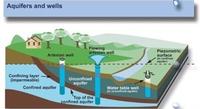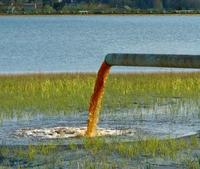-
California communities running out of water
Since January, a number of California communities in the Central Valley have been experiencing such extreme drought that they have been placed on a “critical water systems” list — a ranking indicating that the areas could run completely dry within sixty days. Many of these areas have had wells dried up since July.
-
-
Reduce river pollution through water-quality trading
Allowing polluters to buy, sell, or trade water-quality credits could significantly reduce pollution in river basins and estuaries faster and at lower cost than requiring the facilities to meet compliance costs on their own, a new study finds. The scale and type of the trading programs, though critical, may matter less than just getting them started.
-
-
Cheap, easy-to-install water purifying system for remote communities
About 1.5 million people — and 90 percent of them children — die every year from consuming untreated or contaminated water. University of Adelaide mechanical engineering students and staff have designed a low-cost and easily made drinking water treatment system suitable for remote communities in Papua New Guinea (PNG) — using foil chip packets and some glass tubing.
-
-
Sun-powered desalination for villages in India
Around the world, there is more salty groundwater than fresh, drinkable groundwater. For example, 60 percent of India is underlain by salty water — and much of that area is not served by an electric grid that could run conventional reverse-osmosis desalination plants. MIT researchers show that a different desalination technology called electrodialysis, powered by solar panels, could provide enough clean, palatable drinking water to supply the needs of a typical village.
-
-
Developing portable water purifying device for the U.S. military

Providing a reliable source of purified drinking water for the U.S. soldiers in the field is the focus of a research grant at the Texas A&M Health Science Center School of Public Health. The research aims to develop a portable water treatment device which uses naturally occurring iron in the environment. Researchers say this iron is easily converted to an environmentally friendly chemical compound called ferrate that can be used as a water treatment disinfectant to purify water.
-
-
Purifying polluted water with a six-foot water and solar-powered lens
Water may appear to be an abundant resource, but in some parts of the world clean water is hard to come by. That could change through the work of Deshawn Henry, a University at Buffalo sophomore civil engineering major, who researched how to improve a 6-foot-tall, self-sustaining magnifying glass. Properly termed a water lens, the device uses another abundant resource — sunlight — to heat and disinfect polluted water.
-
-
Electric bugs harnessed to detect water pollution
Scientists have developed a low-cost device that could be used in developing countries to monitor the quality of drinking water in real time without costly lab equipment. The sensor contains bacteria that produce a small measurable electric current as they feed and grow. The researchers found that when the bacteria are disturbed by coming into contact with toxins in the water, the electric current drops, alerting to the presence of pollutants in the water.
-
-
Toledo’s water alarm harbinger of things to come
This past weekend, officials in Toledo, Ohio urged residents and the several hundred thousand people served by the city’s water utility not to drink tap water after discovering elevated levels of microcystin, a toxin caused by algal blooms, in their water supply. Toledo’s water supply has since returned to normal, but nutrient enrichment and climate change are causing an apparent increase in the toxicity of some algal blooms in freshwater lakes and estuaries around the world, scientists say.
-
-
Sewage treatment contributes to antibiotic resistance
Wastewater treatment plants are unwittingly helping to spread antibiotic resistance, say scientists. Researchers found that processing human, farm, and industrial waste all together in one place makes it easier for bacteria to become resistant to a wide range of even the most clinically-effective antibiotics. This is because so many different types of bacteria come together in sewage plants that it gives them a perfect opportunity to swap genes that confer resistance, helping them live. This means antibiotic-resistant bacteria are evolving much faster than they would in isolation.
-
-
Groundwater reservoirs are being depleted at an increasing rate

The rate at which the Earth’s groundwater reservoirs are being depleted is constantly increasing. Annual groundwater depletion during the first decade of this century was twice as high as it was between 1960 and 2000. India, the USA, Iran, Saudi Arabia, and China are the countries with the highest rates of groundwater depletion. About 15 percent of global groundwater consumption is not sustainable, meaning that it comes from non-renewable groundwater resources. The increased use of groundwater for irrigation also results in a rise in sea levels, with roughly one tenth of the total sea level rise during the period from 2000 to 2009 due to groundwater depletion.
-
-
Groundwater could be polluted with heavy metals by fracking flowback
The chemical makeup of wastewater generated by “hydrofracking” could cause the release of tiny particles in soils that often strongly bind heavy metals and pollutants, exacerbating the environmental risks during accidental spills, Cornell University researchers have found. Previous research has shown 10 to 40 percent of the water and chemical solution mixture injected at high pressure into deep rock strata, surges back to the surface during well development. Researchers found that the same properties that make the mixture so effective at extracting natural gas from shale can also displace tiny particles that are naturally bound to soil, causing associated pollutants such as heavy metals to leach out.
-
-
Chemical pollution of European waters is worse than anticipated

Until now environmental authorities and parts of the scientific community have considered toxic chemicals to be rather a local problem affecting only a few bodies of water. A new study, however, reveals for the first time on a large scale the ecological risks emanating from chemical toxicants for several thousands of European aquatic systems. Chemical toxicity represents an ecological threat to almost half of all European bodies of water, and in approximately 15 percent of cases, the biota in freshwater systems may even be subject to acute mortality.
-
-
Turning mining wastewater into rainwater-quality water
A new cost-effective technology to treat mining wastewater and reduce sludge by up to 90 percent has been used for the first time at a commercial mine. The technology, called Virtual Curtain, was used to remove metal contaminants from wastewater at a Queensland mine and the equivalent of around twenty Olympic swimming pools of rainwater-quality water was safely discharged.
-
-
Turning manure into clean water
Imagine something that can turn cow manure into clean water, extract nutrients from that water to serve as fertilizer, and help solve the ever-present agricultural problem of manure management. Technology is under development and near commercialization that can do all of that. While turning the manure into clean water makes environmental sense, the researchers are also looking into how this can make good financial sense for farmers. In some cases it could have a significant impact on the long-term viability of the farm.
-
-
Pumping Central Valley’s ground water increases number of California’s earthquakes
Scientists have offered a new theory explaining the steady increase in the number of small earthquakes in parts of Central California. They say that the quakes are partly due to the pumping of groundwater. Groundwater is heavy, and depresses the Earth’s upper crust like a weight. Without that weight, the earth springs upward and the change in pressure can trigger more small earthquakes.
-
More headlines
The long view
Water Wars: A Historic Agreement Between Mexico and US Is Ramping Up Border Tension
As climate change drives rising temperatures and changes in rainfall, Mexico and the US are in the middle of a conflict over water, putting an additional strain on their relationship. Partly due to constant droughts, Mexico has struggled to maintain its water deliveries for much of the last 25 years, deliveries to which it is obligated by a 1944 water-sharing agreement between the two countries.
